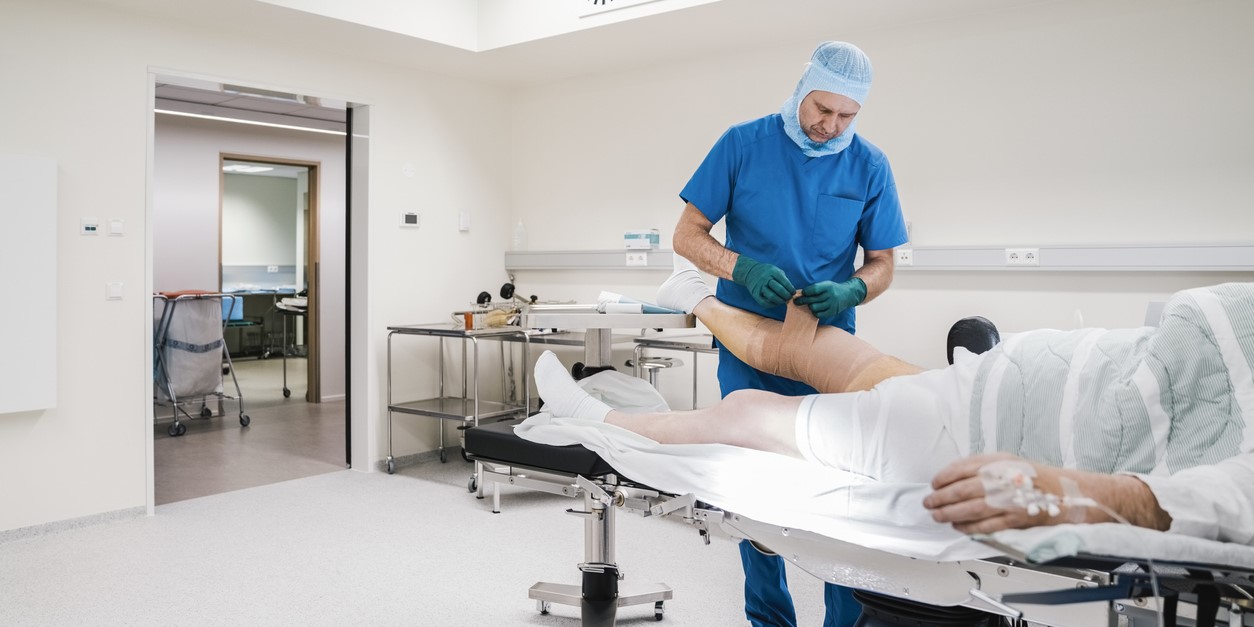A study by the Indian Council of Medical Research (ICMR) found that surgical site infections (SSIs) in three major Indian hospitals exceed rates in many high-income countries, highlighting the need for improved prevention to reduce patient morbidity
Published Jan 14, 2025 | 7:00 AM ⚊ Updated Jan 14, 2025 | 7:00 AM

Knee replacement surgery. (iStock)
A study by the Indian Council of Medical Research (ICMR) revealed that the rate of surgical site infections (SSIs) across three major Indian hospitals surpasses those reported in many high-income countries.
SSIs are among the most common healthcare-associated infections, causing significant patient morbidity, increased healthcare costs, and extended hospital stays, making their prevention critical for improving surgical outcomes and public health.
SSIs occur when harmful microorganisms enter the body through an incision made during surgery, often due to factors such as contamination, prolonged surgery, poor sterilisation, or compromised patient immunity.
With an SSI incidence rate of 5.2 percent, the study places India’s burden higher than the typical range of 1.2 percent -5.2 percent observed in wealthier nations.
The study highlights that orthopedic surgeries, particularly debridement procedures— the surgical removal of dead, damaged, or infected tissue to promote healing and reduce the risk of infection in wounds or surgical sites— combined with amputation, open reduction internal fixation (ORIF), or closed reduction internal fixation (CRIF), had the highest surgical site infection (SSI) rates, reaching 54.2 percent.
The study highlighted a significant gap in data on post-discharge SSIs, particularly in low- and middle-income countries, where such infections often go undetected. India currently lacks a comprehensive surveillance system to monitor SSIs beyond hospital stays.
“To address this, we proposed a multicentric analysis to estimate the proportion and identify the risk factors associated with SSIs occurring during hospital stay and after discharge,” the researchers noted.
The study also said that these findings underscore the need for a standardized national surveillance framework to address possible underreporting and regional disparities. Expanding the study’s scope to represent the entire country would offer a clearer understanding of the problem’s scale.
The research involved 3,020 patients from three prominent institutions: Jai Prakash Narayan Apex Trauma Centre (JPNATC) in New Delhi, Kasturba Hospital (KMC) in Manipal, and Tata Memorial Hospital (TMH) in Mumbai. SSIs, among the most common healthcare-associated infections, are linked to significant morbidity, increased healthcare costs, and longer hospital stays.
Between May 2018 and July 2020, the study monitored 3,090 patients across three hospital, a total of 161 out of 3,090 patients acquired SSI, resulting in a 5.2 percent SSI incidence.
The data revealed that post-discharge surveillance accounted for nearly half (49.7 percent) of the SSI detections, underscoring the need for continued monitoring beyond hospital stays. Orthopedic surgeries, particularly procedures involving open or closed reduction and internal fixation, were associated with the highest infection rates.
SSIs varied significantly across the participating centers, with rates of 7 percent at AIIMS, 1.5 percent at Kasturba Medical College, and a striking 13.5 percent at Tata Memorial Hospital.
Surgical procedures lasting more than 120 minutes were found to substantially increase the risk of SSIs. Contaminated or clean-contaminated wounds and surgeries performed by resident surgeons were also key risk factors.
The authors claimed their study was India’s first multicentric systematic surveillance effort, which monitored patients for six months after they had undergone various conventional surgical procedures.
Post-discharge surveillance helped with the detection of 66 per cent of SSI cases.
Combination surgeries were seen to increase the risk of SSIs in patients. So post-discharge surveillance assisted in diagnosing 50 per cent of SSI patients.
SSIs are one of the most common healthcare-associated infections (HAIs), affecting up to 11.8 percent of surgical procedures in low- and middle-income countries (LMICs), compared to 1.2 percent-5.2 percent in high-income countries, according to WHO data.
SSIs significantly raise patient morbidity, with infected patients often requiring extended hospital stays (median of 17 days in some cases, compared to 7 days for non-infected patients). Mortality rates associated with SSIs can reach 3 percent -5 percent, particularly in cases of deep infections.
SSIs lead to excess healthcare expenditures due to prolonged hospital stays, reoperations, and increased use of antimicrobials. For example, treatment of infected patients can cost up to 2-4 times more than routine post-surgical care.
The prevalence of multidrug-resistant organisms like Klebsiella pneumoniae (21 percent of isolates in the study) complicates treatment, with resistance rates exceeding 60 percent for key antibiotics such as ceftazidime and ciprofloxacin.
In India, nearly 50 percent of SSIs were detected post-discharge, emphasising the critical need for robust and sustained surveillance systems. Without such monitoring, infections may go unreported, underestimating the true burden and delaying interventions.
The study identified 229 microbial isolates from SSI cases, with Klebsiella pneumoniae (21 percent) being the most common. Alarmingly, these pathogens showed high resistance to commonly used antibiotics, such as ceftazidime and ciprofloxacin, complicating treatment protocols and increasing healthcare costs.
Traditionally, SSI monitoring has been limited to the hospital stay, but this approach fails to capture the true burden of infections. The research team developed an indigenous electronic surveillance system to track SSIs for up to six months post-surgery. This initiative enabled early detection and intervention, reducing complications and readmissions.
A hospital-based cross-sectional study conducted over one year in Trichy reported an overall SSI prevalence of 5.5 percent among 2,076 surgical patients. The study found that SSIs were more common in abdominal surgeries (61.2 percent) and noted higher risks in males, younger patients, and those undergoing emergency surgeries. Diabetic patients were particularly at risk, with a significant correlation to infection rates .
Another retrospective cohort study from a tertiary public hospital in South India analysed 200 patients undergoing elective and emergency surgeries. The overall SSI rate was 11 percent, with emergency surgeries showing a higher incidence (13 percent) compared to elective ones (9 percent). Staphylococcus aureus was identified as the most common pathogen, isolated from 36 percent of SSI cases. Factors such as old age, pre-existing medical conditions, and wound contamination were linked to increased SSI risks.
(Edited by Ananya Rao)
